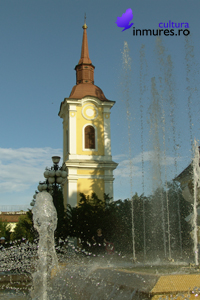
The Tower of the Franciscan Church
The tower in the Theater Square is proof of the prior existence of a church, of which it was an integral part. The central area of the city which is now marked by the large open space toward the National Theater looked very differently 35 years ago. Here were the walls of on old church built in the middle of the 18th century by the Franciscan monks who had returned to town. The existence of the Franciscan order in Tîrgu-Mureș was directly affected by the religious reform which was largely spread in Transylvania during the 16th century. In 1557 the influence of the Reformed Church over the Hungarian population in Tirgu Mures was so strong that it eventually led to the confiscation of the properties of Catholic monastic orders. Franciscan monks, who until that time had been attending the church in the fortress, were forced to leave town. They returned after nearly two centuries when the political climate had become favorable to Catholicism due to the instauration of the Hapsburgs in Transylvania. They bought the land in the center of the town where they built a new church and monastery by 1777. The tower, the only part that is still standing, was added to the church's facade in 1802 by architect Topler János. The entire ensemble bore the imprint of the Baroque style specific to that period, but the most relevant elements can be seen on the tower. The photographs of the time prove that the tower dominated the ensemble not only due to its exterior decoration, but also by its impressive size. Vertically, it is divided into two registers delimited by a well-relieved cornice. The facades are articulated in the corners by pilasters with Doric caps. The inferior register is dominated by the main portal and the niche that holds the statue of Saint Francis. Underneath the massive cornice that separates the two registers there is a round window. The top register also has semi-circular windows on all its four sides, above which there are circles made of plaster corresponding to the round windows in the lower register. The cornice underneath the roof follows these circles on the upper part, and thus the roof is also curved. The roof itself, with its bulb shape and arrow on top, is a perfect example of the Baroque style. In addition to the tower, the mortuary chamber is the other part of the old church that still exists; it is underground, where the old church's nave used to be. In 1971 the municipality decided to demolish the monastery to create the necessary space for the construction of the National Theater and the square in front of it. A new church was built for the Franciscans on Libertății street. Some elements of the old church were used to build the new one. Such are, for instance, the stained glass windows of the nave that had been made in 1899. These depict Saint Stephen, Saint Emeric, Saint Francis, Saint Anthony, Saint Elisabeth and the heart of Jesus.
An aura of mystery was created around the tower in the Theater Square and the catacombs it leads to, which generated a series of urban legends that talk about the existence of a network of secret underground corridors .
Bibliography:
Ioan Eugen Man, Tîrgu-Mureș, istorie urbană de la începuturi până în 1850, Tîrgu-Mureș, Ed. Nico, 2006, pp. 205-206

